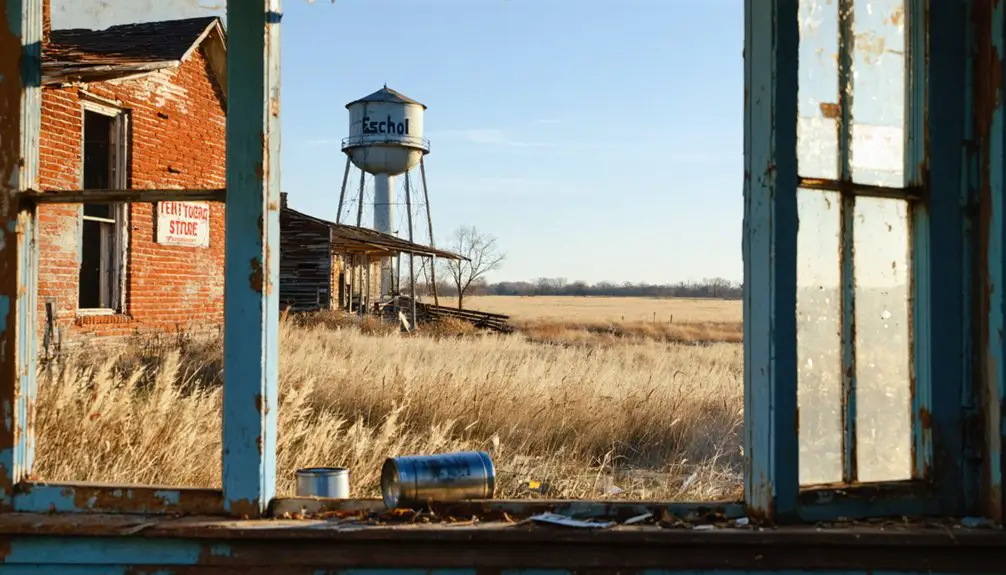You’ll find Eschol’s ghost town story in Michigan’s early frontier history, where this 1833 settlement once thrived through logging, farming, and river trade along the St. Joseph River. Despite its promising start with essential services and postal connections, Eschol couldn’t compete with Three Rivers’ strategic railroad advantages and industrial growth. The town’s decline showcases how economic rivalry shaped Michigan’s development, while its abandoned remnants hold deeper insights into 19th-century frontier life.
Key Takeaways
- Eschol was established in 1833 as a frontier settlement in Michigan, initially prospering through logging, farming, and small-scale trade activities.
- The town’s decline was primarily due to losing economic competition with Three Rivers, which secured crucial railroad access and industrial development.
- Eschol relied heavily on river transport via St. Joseph River for trade, using flatboats to ship goods downstream.
- Failed industrial development and inability to attract major employers like Continental Can Corporation contributed to Eschol becoming a ghost town.
- The settlement represents a typical Michigan boom-bust cycle, particularly common among 19th-century logging towns that couldn’t sustain economic growth.
The Rise of a Promising Settlement (1833-1840)
During the early years of Michigan’s territorial expansion, Eschol emerged in 1833 as a promising frontier settlement, capitalizing on its strategic location and access to essential resources. The settlement origins reflected the period’s westward movement, drawing settlers from eastern states who sought opportunity in Michigan’s developing interior.
You’d have found a bustling community forming around essential services, with roads and postal connections facilitating growth. Similar to nearby Columbus, which established itself along the Gratiot Turnpike, the settlement’s early prosperity stemmed from logging, farming, and small-scale trade operations. Just as Bete Grise Harbor provided safe haven for ships during storms, Eschol’s location offered natural protection for travelers and merchants.
Community dynamics centered on family-based social structures, with churches and schools establishing themselves as population increased. Economic activity flourished through general stores, blacksmith shops, and milling operations, while the town’s strategic positioning near transportation routes enhanced its commercial potential.
These foundations suggested a bright future for Eschol’s development.
Life Along Michigan’s Riverbanks
While indigenous peoples had long recognized Michigan’s riverbanks as essential lifelines, these waterways became important nexus points of settlement and commerce for successive waves of inhabitants.
You’d have found Paleo-Indians hunting along the Huron River 9,000 years ago, followed by Archaic Boreal Indians who adapted their river ecology practices to changing climates. The ancient hunters built V-shaped boulder blinds to aid in their caribou hunting activities.
French traders later established posts near these same waters, drawn by the rich resources that had sustained indigenous practices for millennia. Local Native Americans called it Nummasepee, meaning River of Sturgeon.
European settlements emerged along Michigan’s waterways, capitalizing on natural wealth that indigenous peoples had stewarded for thousands of years.
The rivers’ impact on daily life was profound – you’d have seen toll bridges spanning the River Raisin by 1819, communal mill-raisings defining social bonds, and steamers connecting inland settlements through Detroit’s port by 1836.
These waterways shaped everything from transportation to farming patterns, binding communities together through shared resources and activities.
The Fatal Dam Collapse
You’ll find that Eschol’s fate was sealed on May 19, 2020, when the Edenville Dam‘s poorly compacted sandy embankment catastrophically failed through static liquefaction, releasing a wall of water from Wixom Lake that also breached the downstream Sanford Dam.
The failed dam had a long history of issues, having lost its license in 2018 due to non-compliance with safety regulations.
When the floodwaters receded, they left behind over $200 million in damage across 2,500 structures and devastated communities, forcing many residents to permanently abandon their properties along the drained lakebed. The devastating flood prompted emergency evacuations of tens of thousands of residents from the affected areas.
The dam failures, which engineers later determined were entirely preventable, triggered an exodus that transformed once-thriving waterfront neighborhoods into vacant lots, fundamentally altering Eschol’s character and economic foundation.
Sudden Infrastructure Failure
On May 19, 2020, the 96-year-old Edenville Dam suffered a catastrophic failure when its east embankment collapsed due to static liquefaction, triggering a devastating flood wave that impacted over 2,500 structures and caused more than $200 million in damages.
Timely evacuations of approximately 10,000 residents prevented an estimated 10-20 deaths.
You’ll find this disaster exposed critical infrastructure vulnerabilities that had developed over decades.
The dam’s embankment contained loose, poorly compacted sandy soils that violated original construction specifications. Its downstream slope was steeper than required at 1.8:1 rather than the specified 2:1 ratio.
When water levels rose 5.5 feet above normal after heavy rainfall, the high pressure triggered soil liquefaction near the downstream toe.
Despite warnings and incomplete safety assessments, regulators and owners failed to address these weaknesses, highlighting the devastating consequences of inadequate disaster preparedness.
This catastrophe echoes the historic dam collapse of 1840 that led to Eschol’s complete abandonment and eventual ghost town status.
Economic Ripple Effects
The catastrophic dam failure triggered economic devastation far beyond the immediate physical destruction. You’ll find the ripples spread through every sector of the local economy, with over $200 million in damages crippling both private property and public infrastructure.
The draining of Wixom Lake dealt a severe blow to tourism-dependent businesses, while real estate values plummeted as waterfront properties lost their appeal. Boyce Hydro’s negligence led to $120 million in additional fines that further strained the region’s economic recovery. Many residents faced devastating financial hardship as most homes lacked flood insurance coverage.
Your community’s economic recovery faced significant hurdles as unemployment spiked and tax revenues declined. While construction work provided some temporary relief, it couldn’t offset the broader losses.
The disaster strained community resilience, with businesses struggling against decreased visitor numbers and lost revenue. Insurance premiums rose sharply, and many local governments grappled with reduced budgets for essential services, highlighting the far-reaching consequences of infrastructure failure.
Community Mass Exodus
When floodwaters breached the Edenville Dam at 17:46 EDT on May 19, 2020, they triggered an unprecedented mass exodus of over 10,000 residents from Edenville, Sanford, and Midland communities.
You’ll find that the community’s emergency preparedness was immediately put to the test as authorities rushed to evacuate residents while maneuvering COVID-19 social distancing requirements.
The evacuation proved especially challenging as floodwaters permanently altered the region’s geography, carving new river channels and reshaping the landscape.
Your understanding of community resilience will deepen knowing that displaced families had to adapt quickly, with many seeking emergency shelter services while state regulators launched investigations into Boyce Hydro’s negligence.
The catastrophic failure transformed thriving neighborhoods into abandoned zones, fundamentally altering the social fabric of these close-knit Michigan communities.
Economic Competition With Three Rivers

While Eschol struggled to compete for trade routes and markets, Three Rivers leveraged its strategic railroad access to build a robust industrial base anchored by major employers like Continental Can Corporation and Armstrong and Johnson.
Three Rivers’ manufacturing economy diversified into automotive supply chains through companies like Metal Technologies and Peterson Spring, while Eschol failed to develop comparable industrial capacity.
The stark economic disparity between the two communities widened as Three Rivers attracted a larger workforce and established lasting partnerships with manufacturers, leaving Eschol unable to sustain competing industries or maintain its economic viability.
Trade Routes and Markets
Situated along essential waterways fed by the St. Joseph River, Eschol’s trade logistics relied heavily on river transport to move goods to broader markets.
You’d find flatboats and arks carrying up to 600 barrels of flour downstream, while smaller vessels transported wheat and seed potatoes through the intricate river system.
The town’s millpond and millrace powered the Constantine Milling Company, transforming raw agricultural products into valuable exports.
However, you’d face significant challenges shipping goods from Eschol – canoe trips could take ten days, and you’d often have to wait six months for payment after shipment.
The seasonal nature of river trade meant timing was vital, with fall and spring offering the best conditions for moving flour to eastern markets through St. Joseph port.
Industrial Growth Rivalry
As Three Rivers rapidly diversified its industrial base in the late 1800s, you’d find Eschol struggling to compete with its neighbor’s growing manufacturing prowess.
While Eschol relied primarily on water-powered sawmills, shingle mills, and basic grain processing, Three Rivers was building an impressive portfolio of industries including blacksmith shops, woolen factories, carriage makers, and distilleries.
The industrial rivalry between the two communities became increasingly one-sided as Three Rivers expanded into railcar manufacturing with Sheffield Car Company, paper production, and eventually large-scale operations like Continental Can Corporation.
Three Rivers’ economic strategies proved more successful through its embrace of railroad connections and diversified manufacturing.
You’ll see how this disparity in industrial development ultimately contributed to Eschol’s decline, while Three Rivers continued to adapt and thrive through various economic shifts.
Resource Competition Dynamics
The economic contest between Eschol and Three Rivers extended beyond industrial development into fierce competition for limited regional resources.
You’ll find that Three Rivers’ advantageous location at the confluence of rivers gave it a distinct edge in resource allocation, particularly regarding transportation infrastructure and trade access. The town’s competitive strategies included aggressive municipal incentive programs and tax breaks to attract businesses, while Eschol struggled to match these offerings.
The rivalry intensified through local policies aimed at economic development, with both communities vying for timber, water rights, and infrastructure investment.
Three Rivers’ superior geographic position and stronger infrastructure made it more attractive to industries, while Eschol’s peripheral location and limited resources ultimately contributed to its economic decline and eventual ghost town status.
Daily Life in Early Eschol
Life in early Eschol proved harsh and unforgiving for the initial settlers who arrived in the mid-1840s. You’d have found yourself struggling through daily routines of hunting, fishing, and tending to modest gardens once the ground thawed.
During the first brutal winter, you would’ve huddled in cold, damp shelters while Lake Michigan’s frozen waters cut off essential supply lines. Your survival depended on limited trade with Anishinaabe people for basic provisions.
As the settlement grew, your social gatherings would’ve centered around the general store’s upper floor for community dances. You’d have sent your children to the newly built schoolhouse, attended church services, and participated in a growing network of European immigrant families.
Your food options expanded with cattle arriving from Chicago, while local sawmills and gristmills supported the community’s development.
The Aftermath and Abandonment
Despite initial promise and community growth, Eschol’s existence proved remarkably brief, lasting only from 1833 to 1840.
Multiple abandonment causes converged to seal the town’s fate, including the likely depletion of local resources and challenges with transportation access. You’ll find that the community decline accelerated as families and businesses relocated to nearby towns offering better economic prospects.
While many Michigan ghost towns left behind visible ruins, Eschol’s short lifespan resulted in few lasting remnants.
Today, you’d see little evidence of the former settlement beyond possible foundations or cemetery traces, as nature has reclaimed the land.
The town’s legacy lives on primarily as a reflection of the economic vulnerabilities faced by early Michigan settlements and the harsh realities of frontier life.
Historical Significance in Michigan’s Ghost Town Legacy
Among Michigan’s numerous ghost towns, Eschol stands as a prime example of resource-driven settlements that shaped the state’s industrial development during the 1800s.
Eschol’s legacy mirrors the broader story of Michigan’s rapid industrialization and subsequent decline, particularly in the northern regions where logging dominated the economy.
You’ll find that Eschol’s significance extends beyond its physical boundaries through:
- Its representation of the boom-bust cycle typical of logging towns
- Its role in Michigan’s timber industry transformation
- Its contribution to understanding 19th-century immigrant worker communities
While less documented than some ghost towns, Eschol’s impact on Michigan’s development helps you understand the profound effects of resource extraction on settlement patterns.
The town’s story continues to inform historians and archaeologists about the environmental and social consequences of Michigan’s logging era.
Frequently Asked Questions
Are There Any Remaining Artifacts or Structures From Eschol Visible Today?
Standing in empty Michigan wilderness, you won’t find any remaining structures or historical artifacts from Eschol today – the town existed primarily on paper, leaving no physical traces behind for modern explorers.
What Happened to the Original Residents After Leaving Eschol?
You’ll find former Eschol residents scattered to nearby towns with railroads and better jobs, shifting from resource-based work to manufacturing and services, while maintaining some social connections despite their dispersed post-Eschol life.
Were There Any Attempts to Rebuild Eschol After 1840?
You won’t find evidence of rebuilding efforts at Eschol after 1840. The town’s historical significance remained only through preservation efforts, as residents moved to more profitable mining locations rather than attempting reconstruction.
What Was the Exact Location of Eschol in Relation to Modern Landmarks?
You’ll find this forgotten settlement at 41° 54.557′ N, 85° 38.349′ W, about 0.1 miles north of Shorewood Drive on Constantine Road, near modern-day Three Rivers in St. Joseph County, Michigan.
Did Any Businesses or Industries Survive by Relocating to Three Rivers?
You’ll find no confirmed records of specific business relocations or industry survival from Eschol to Three Rivers, though regional patterns suggest small agricultural and retail enterprises likely moved to survive economically.
References
- https://99wfmk.com/escholghosttown/
- https://kids.kiddle.co/List_of_ghost_towns_in_Michigan
- https://books.google.com/books?id=ZGgCAAAACAAJ&cad=3
- https://www.pinterest.com/pin/976507131712950868/
- https://catalog.tln.lib.mi.us/?section=search&term=bid:314972
- https://99wfmk.com/columbus-michigan/
- https://www.visitkeweenaw.com/blog/post/our-top-7-keweenaw-ghost-towns-to-explore/
- https://www.nailhed.com/2017/10/the-ghost-town-that-moved.html
- https://www.youtube.com/watch?v=7-vjuqiGWJU
- https://www.hmdb.org/m.asp?m=75319


